If you like salmon, you will LOVE this salmon jerky recipe! It tastes like light fish and ends with a nice smokey and salty taste. Just perfect!.
When it comes to fat content in fish, salmon ranks on the higher end. If you have been reading about jerky, fat is not a good thing. But salmon still makes GREAT jerky!.
I’ll show you how to make salmon jerky that is much better than store-bought kinds.
Making your own salmon jerky at home is easy, fun, and gives you delicious jerky packed with flavor. Salmon jerky is the perfect high-protein snack to grab for hiking, camping, or just to keep on hand for when hunger strikes. With a few simple ingredients and minimal equipment, you can make flavorful salmon jerky that rivals any you can buy in stores.
Why Make Homemade Salmon Jerky?
There are several great reasons to make your own salmon jerky
-
Save Money – Homemade costs a fraction of what you’d pay for prepackaged jerky. Buying salmon on sale and dehydrating it yourself keeps costs down.
-
Avoid Preservatives – Store-bought jerky contains lots of sugar sodium and preservatives. Homemade lets you control all the ingredients.
-
Customize Flavors—You can try out different spices and seasonings to make your own unique flavor.
-
Make Use of Excess Fish – Dehydrate leftover baked or smoked salmon. Or preserve that fish stockpiled in your freezer from a bountiful fishing trip.
-
PortableProtein Source – Jerky is lightweight,travels well, and provides a good energy boosting protein punch
How to Make Salmon Jerky Step-By-Step
Making salmon jerky involves just a few simple steps: curing the raw fish, dehydrating it, and optional flavoring.
Ingredients:
- 1-2 lbs salmon fillet, skin removed
- 1/2 cup brown sugar or honey
- 1/2 cup soy sauce or tamari
- 1 tbsp garlic powder
- 1 tbsp fresh ground black pepper
Equipment:
- Sharp knife
- Resealable plastic bag
- Dehydrator (or oven set to lowest temp)
Step 1: Slice the Salmon
- Partially freeze raw salmon fillets to make slicing easier. Slice salmon against the grain into long 1/4 inch thick strips.
Step 2: Make the Cure
-
In a bowl, stir together brown sugar or honey, soy sauce, garlic powder, and black pepper.
-
Place salmon strips in a resealable plastic bag. Pour the cure over salmon and seal bag.
-
Marinate salmon in cure 12-24 hours in the fridge, flipping bag occasionally.
Step 3: Dehydrate the Salmon
-
Drain salmon and discard marinade. Pat strips dry with paper towels.
-
Arrange strips in a single layer on dehydrator trays, making sure not to overlap.
-
Dehydrate at 145°F for 6-10 hours until strips are dried thoroughly but still pliable.
Step 4: Flavor (Optional)
-
After the strips are dry, you can brush them with maple syrup or bourbon or add chili powder, crushed peppercorns, or other spices.
-
Let added flavors soak in for 30 minutes before storing jerky.
Step 5: Store Properly
- Cool completely. Store jerky in airtight bags or jars up to 2 months at room temperature or 6 months refrigerated.
And that’s it! With just a few basic steps, you can easily make delicious salmon jerky at home. Experiment with flavors and enjoy a healthy snack anywhere.
Salmon Jerky Flavor Ideas
One of the best parts of making your own salmon jerky is customizing the flavors. Here are some amazing flavor combinations to try:
-
Lemon Pepper – Fresh lemon zest and coarse cracked black pepper
-
Teriyaki – Soy sauce, honey, garlic, ginger
-
Chili Lime – Lime zest, chili powder, cumin, red pepper flakes
-
Cajun – Cajun seasoning, paprika, cayenne, garlic
-
Bourbon – Brush strips with bourbon after dehydrating
-
Thai – Brown sugar, lime, red curry paste, crushed peanuts
-
Jamaican Jerk – Traditional Jamaican jerk spices
-
Everything Bagel – Toasted sesame seeds, garlic, onion, poppy seeds
Tips for Making Perfect Salmon Jerky
Follow these tips and tricks for getting the best results every time:
-
Use sushi-grade salmon for raw preparations. Or fully cook salmon before dehydrating.
-
Cut uniform, thin strips to ensure even drying. Around 1/4 inch works best.
-
Rotate the jerky and move pieces around for even air flow as it dehydrates.
-
Put a bowl of water in the dehydrator to provide moisture and prevent excess drying.
-
Let jerky cool completely before storing. Condensation can develop on warm jerky and make it soggy.
-
Vacuum seal portions in bags and refrigerate or freeze for longer storage life.
Make Jerky from Other Fish
While salmon makes amazing jerky, you can also use this method with other types of fish:
-
Halibut – Firm texture holds up well when dried
-
Tuna – Meaty with lots of rich flavor
-
Steelhead Trout – Mildly sweet taste
-
Mahi Mahi – Delicate, mild flavor
-
Cod or Haddock – Affordable, readily available
-
Bass or Trout – Freshwater options, especially for inland regions
Any oily fish will work well for making jerky. Just remember to adjust dehydrating times based on thickness of fillets. And as always, smell and taste test for doneness, drying until just slightly pliable but not brittle.
Frequently Asked Questions
Can you use canned salmon?
Yes, canned salmon works perfectly! Drain it well, flake the salmon into smaller chunks, then marinate and dehydrate as usual.
What if I don’t have a dehydrator?
You can use your oven on the lowest setting, usually around 140-170°F. It just takes longer. Crack the oven door open to allow moisture to escape.
How long does homemade salmon jerky last?
Properly stored in airtight containers, salmon jerky will keep 2 months at room temp or 6 months refrigerated or frozen.
Can you rehydrate jerky if it gets too dry?
Unfortunately rehydrating won’t make jerky tender again. For best texture, stop dehydrating while jerky still has a slight flex and chew.
Is smoked salmon already cooked?
If using store-bought smoked salmon, it’s safe to eat as-is without cooking. Otherwise, fully cook salmon before dehydrating for food safety.
Homemade salmon jerky makes a delicious and nutritious snack using basic ingredients and techniques. With so many flavor options, you can create jerky perfectly suited to your taste buds. Whip up a big batch for munching anytime!

How to make salmon jerky
I started with a wild caught sockeye salmon fillet that I purchased from my local grocery store. When I make smoked salmon or dehydrated salmon jerky, I always buy salmon that was caught in the wild.
The taste is sooo much better when it is wild caught. You can tell wild caught from farm raised because of the dark red color of the meat.
Run your fingers over the meat to feel for any pin bones. This picture shows salmon fillets that had a lot of pin bones. Other fillets have had none at all.
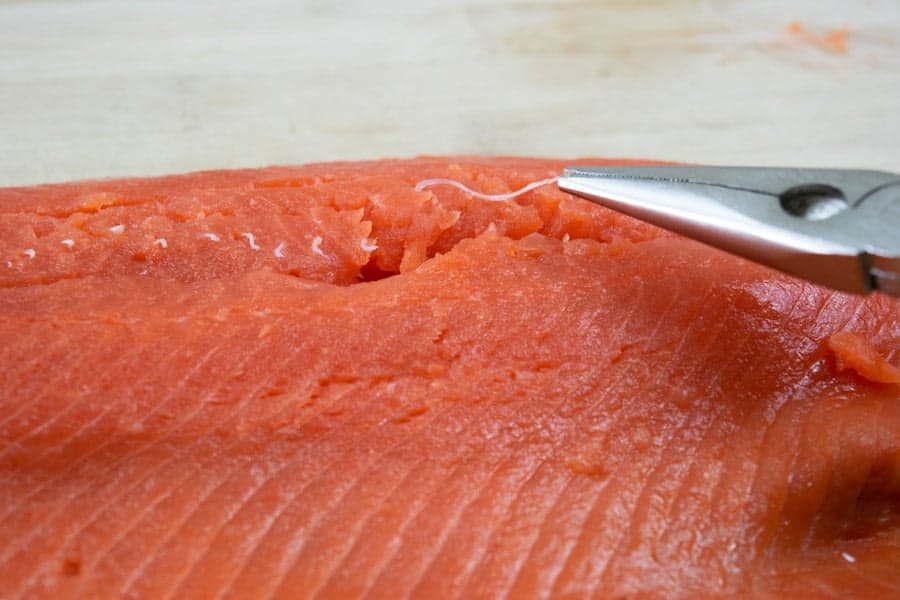
They will feel hard and be white in color. I use standard needle nose pliers to pull them out. They should pull out easily with a little wiggling. Dont forget this step, no one likes bones in their jerky!.
Here is where you can either skin the fillet or leave the skin on. I like leaving the skin on because it keeps the meat together. If you remove the skin now, the strips can break apart easily during marinating.
Once you are done drying, the skin will peel off easily before you eat the jerky.
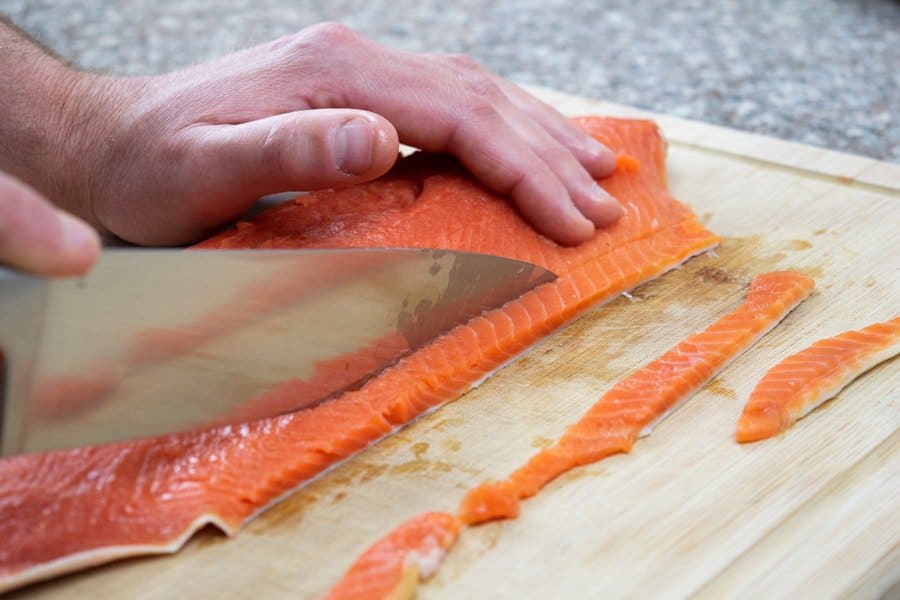
Using a very sharp knife, slice ¼” – ½” wide salmon strips down the length of the fillet. Slicing from the “head” of the fillet to the “tail”.
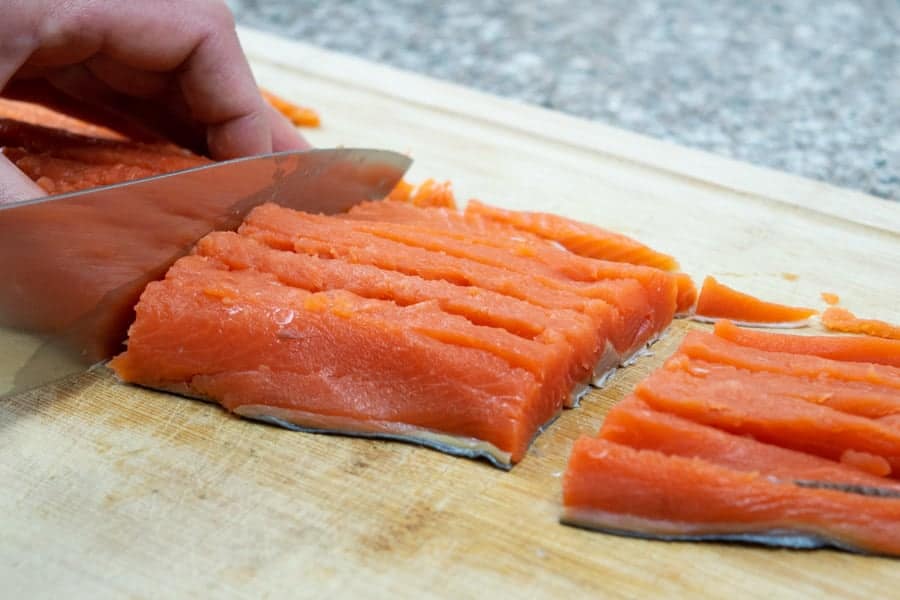
After all the strips are sliced lengthwise, cut across the strips to your desired length. I normally cut mine between 3-4″ long for this salmon jerky recipe.
Mix all the marinade ingredients together in a ziplock bag and add the salmon strips carefully.
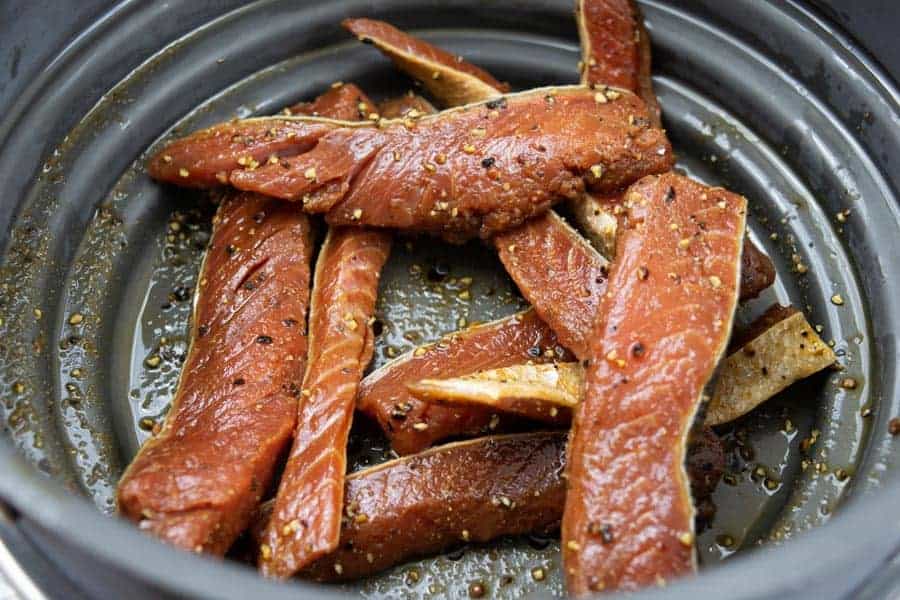
For 18 hours, I put the salmon strips in a ziplock bag and put them in the fridge with the salmon jerky recipe below. Mix up the strips in the bag several times during marinating to ensure all strips are evenly marinated.
Strain the salmon strips in a colander and pat dry with paper towels to remove any excess marinade.
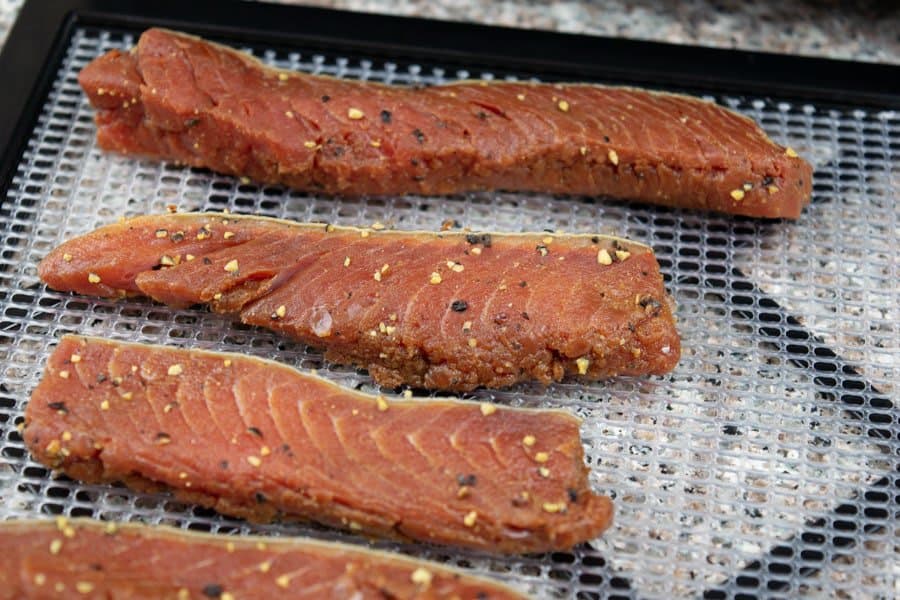
Lay the strips on dehydrator trays or a cooling rack if drying with your oven. Make sure none of the pieces are touching and there is amble room in between for air to circulate. I used my Excalibur Dehydrator when making this recipe.
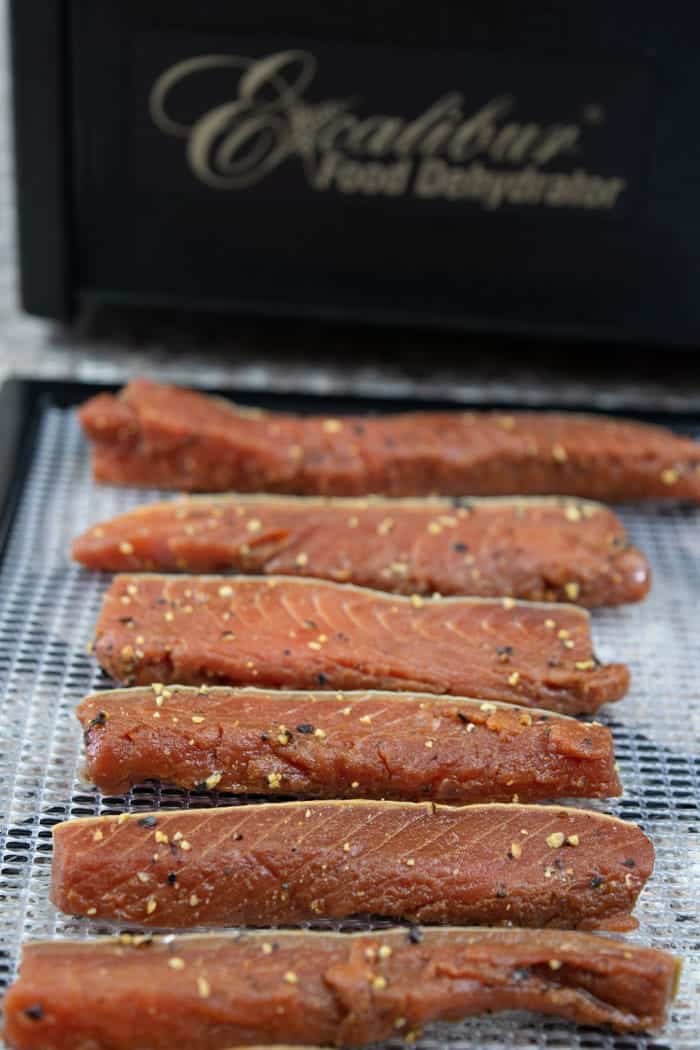
Let the strips dry at 150°F or as low as your oven will go until they are done. Because salmon is high in fat, I like to dry it out more than fish that is low in fat, like my trout jerky recipe. It took this jerky 9 hours to be just perfect.
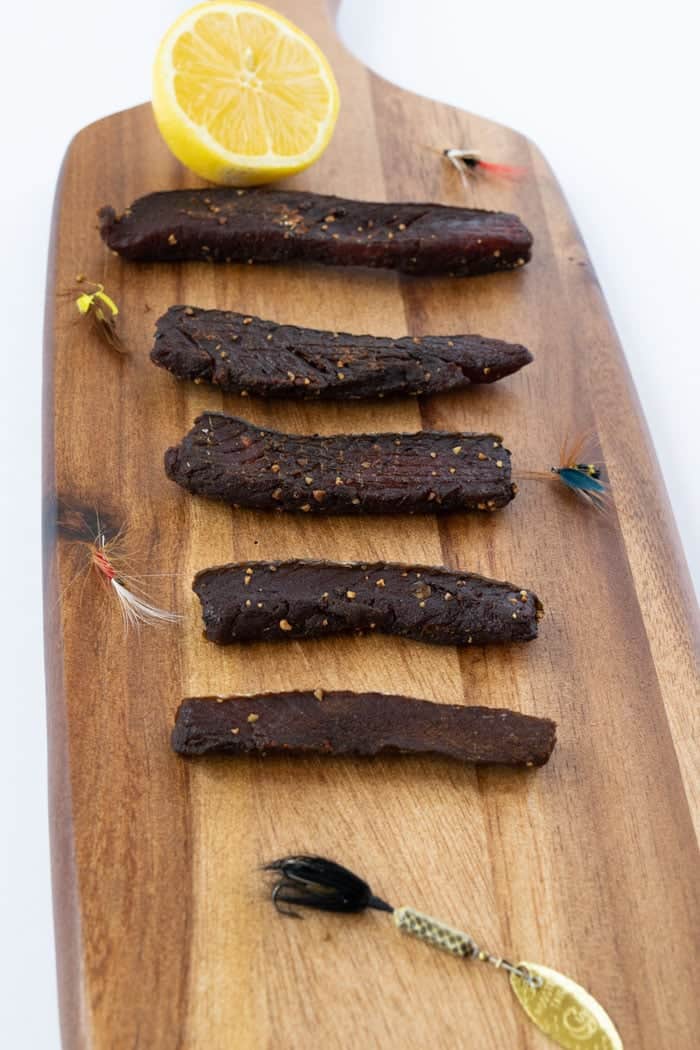
It worked out GREAT! The smokey taste from the liquid smoke and the salty taste from the soy sauce make this salmon jerky taste great.
If you love salmon, you HAVE to make this jerky. Now all you have to do is peel the skin off and eat!.
Try making these other JERKY RECIPES:

